Papers by Prof. Tusar Kanti Behera
Indian Journal of Agricultural Sciences, Nov 16, 2018
Vegetable Science, Feb 10, 2024
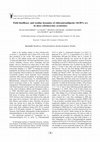
The Indian Journal of Agricultural Sciences
The okra fruit borer (Earias vittella) and sucking pests are a key limiting factor in okra cultiv... more The okra fruit borer (Earias vittella) and sucking pests are a key limiting factor in okra cultivation due to their severe crop destruction behaviour. An experiment was conducted during 2019–20 to assess the bioefficacy of various new insecticides and persistence of chlorantraniliprole 18.50 sc residues in okra fruits at research farm of ICAR- Indian Institute of Vegetable Research, Varanasi, Uttar Pradesh. Among various treatments, chlorantraniliprole tested at 30 g a.i./ha was reported to be effective in reducing fruit damage by E. vittella (96%), as well as sucking pests infestation (87.81–1100%) with a significantly higher marketable fruit yield (8.88 t/ha) recorded under open field situations. Ethyl acetate was used to extract the chlorantraniliprole contaminants from the okra fruit matrix, and PSA and magnesium sulphate were used to clean up the matrix. The estimate for the limit of quantification (LOQ) was 0.01 mg/kg, and the average percent recoveries ranged from 83.67–89.00...

Genetics and molecular research : GMR, Jan 23, 2017
Rice (Oryza sativa L.) blast disease is one of the most destructive rice diseases in the world. T... more Rice (Oryza sativa L.) blast disease is one of the most destructive rice diseases in the world. The fungal pathogen, Magnaporthe oryzae, is the causal agent of rice blast disease. Development of resistant cultivars is the most preferred method to achieve sustainable rice production. However, the effectiveness of resistant cultivars is hindered by the genetic plasticity of the pathogen genome. Therefore, information on genetic resistance and virulence stability are vital to increase our understanding of the molecular basis of blast disease resistance. The present study set out to elucidate the resistance pattern and identify potential simple sequence repeat markers linked with rice blast disease. A backcross population (BC2F1), derived from crossing MR264 and Pongsu Seribu 2 (PS2), was developed using marker-assisted backcross breeding. Twelve microsatellite markers carrying the blast resistance gene clearly demonstrated a polymorphic pattern between both parental lines. Among these,...
Engei Gakkai zasshi, 2003
Journal of Tropical Agriculture, 2007
Vegetable Science, Dec 28, 2023
Vegetable Science, Feb 10, 2024
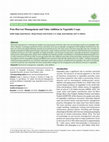
Vegetable Science, Feb 10, 2024
Horticultural production is reaching new heights every passing year. Presently, India is the seco... more Horticultural production is reaching new heights every passing year. Presently, India is the second largest producer of vegetables after China. However, humongous postharvest losses and waste occur due to improper management and handling. Postharvest loss has been one of the main global challenges towards ensuring food security. This waste seems inhumane especially when tens of millions of people worldwide are suffering from hunger, malnutrition, under-nutrition and other chronic diseases while the food waste contributes to global warming as well. Fresh vegetables are highly perishable. Lack of proper transportation, especially temperature management during transit and storage further reduces their storability and marketing window. United Nations sustainable developmental goal 2 aims to reduce food losses by 50% by 2030. Several approaches like value addition particularly drying technology, temperature and storage atmosphere control, using edible coatings and different anti-senescent molecules like salicylic acid, nitric oxide, 1-methylcyclopropene, methyl jasmonate, polyamines, etc. have been undertaken worldwide to enhance storability of fresh vegetables. This review is an attempt to present a bird' eye view of postharvest losses and possible strategies for the management and reduction of losses in vegetables.
Vegetable Science, Dec 26, 2021
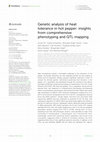
Frontiers in Plant Science
High temperatures present a formidable challenge to the cultivation of hot pepper, profoundly imp... more High temperatures present a formidable challenge to the cultivation of hot pepper, profoundly impacting not only vegetative growth but also leading to flower and fruit abscission, thereby causing a significant reduction in yield. To unravel the intricate genetic mechanisms governing heat tolerance in hot pepper, an F2 population was developed through the crossing of two distinct genotypes exhibiting contrasting heat tolerance characteristics: DLS-161-1 (heat tolerant) and DChBL-240 (heat susceptible). The F2 population, along with the parental lines, was subjected to comprehensive phenotyping encompassing diverse morphological, physiological, and biochemical heat-related traits under high temperature conditions (with maximum temperature ranging from 31 to 46.5°C and minimum temperature from 15.4 to 30.5°C). Leveraging the Illumina Nova Seq-6000 platform, Double digest restriction-site associated DNA sequencing (ddRAD-seq) was employed to generate 67.215 Gb data, with subsequent alig...

The Indian Journal of Agricultural Sciences
An experiment was carried out to analyze genetic divergence through multivariate analysis based o... more An experiment was carried out to analyze genetic divergence through multivariate analysis based on D2 and principal component analysis (PCA) for 24 yield contributing traits among 67 muskmelon (Cucumis melo L.) genotypes from 3 horticultural groups. The 67 genotypes were grouped into 15 distinct clusters. Cluster I consisted of 27 exotic lines from inodorous and cantalupensis group followed by cluster XIVwith 14 genotypes. Majority of genotypes of cluster XIV were developed in India except 4 exotic lines. The remaining13 clusters comprised of only 2 genotypes each and thus clustering pattern indicated enough genetic divergence in the germplasm under study. The highest value of intra cluster distance (43. 68) was found for cluster XV with 2 genotypes followed by XIV (38. 35) possessing 14 genotypes and cluster I (31. 07) having 27 genotypes. The highest inter cluster distance was observed between cluster XV and XIV (42. 24), followed by the cluster XV and XI (40. 70) and cluster XV a...
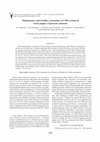
The Indian Journal of Agricultural Sciences
CMS based breeding is essentially a 3-line hybridization method which requires stable CMS line, m... more CMS based breeding is essentially a 3-line hybridization method which requires stable CMS line, maintainer line and restorer of fertility line. To identify maintainer (B) and restorer of fertility (R) lines for five stable CMS lines in capsicum, the present experiment was conducted in line × tester mating design at ICAR-IARI, Regional Station, Katrain (HP), India during summer season of 2015 and 2016. The results revealed that among 125 F1s, pollen fertility percent, pollen germination percent, self fruit setting rate and seed number per fruit in C1 × P1, C2 × P2, C2 × P12, C3 ×P3, C3 × P12, C4 × P4, C4 × P12 and C5 × P5 were recorded nil. It revealed that testers in these crosses could be maintainer line (N rfrf) for maintaining sterility in their maternal parent in the cross, whereas in C1 × P6, P15, P10, P9, P14, P8, P7; C2 × P8, P14, P15, P9, P10, P13, P7; C3 × P7, P9, P10; C4 × P23, P24, P7, P21, P6, P9, P10 and C5 × P21, P9, P10 crosses pollen fertility percent w...

Frontiers in Plant Science
Plant productivity is being seriously compromised by climate-change-induced temperature extremiti... more Plant productivity is being seriously compromised by climate-change-induced temperature extremities. Agriculture and food safety are threatened due to global warming, and in many cases the negative impacts have already begun. Heat stress leads to significant losses in yield due to changes in growth pattern, plant phonologies, sensitivity to pests, flowering, grain filling, maturity period shrinkage, and senescence. Tomato is the second most important vegetable crop. It is very sensitive to heat stress and thus, yield losses in tomato due to heat stress could affect food and nutritional security. Tomato plants respond to heat stress with a variety of cellular, physiological, and molecular responses, beginning with the early heat sensing, followed by signal transduction, antioxidant defense, osmolyte synthesis and regulated gene expression. Recent findings suggest that specific plant organs are extremely sensitive to heat compared to the entire plant, redirecting the research more tow...

Frontiers in Plant Science
Cucumber is an extremely perishable vegetable; however, under room conditions, the fruits become ... more Cucumber is an extremely perishable vegetable; however, under room conditions, the fruits become unfit for consumption 2–3 days after harvesting. One natural variant, DC-48 with an extended shelf-life was identified, fruits of which can be stored up to 10–15 days under room temperature. The genes involved in this economically important trait are regulated by non-coding RNAs. The study aims to identify the long non-coding RNAs (lncRNAs) and circular RNAs (circRNAs) by taking two contrasting genotypes, DC-48 and DC-83, at two different fruit developmental stages. The upper epidermis of the fruits was collected at 5 days and 10 days after pollination (DAP) for high throughput RNA sequencing. The differential expression analysis was performed to identify differentially expressed (DE) lncRNAs and circRNAs along with the network analysis of lncRNA, miRNA, circRNA, and mRNA interactions. A total of 97 DElncRNAs were identified where 18 were common under both the developmental stages (8 dow...
International Journal of Current Microbiology and Applied Sciences, 2018
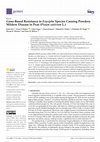
Genes, 2022
Globally powdery mildew (PM) is one of the major diseases of the pea caused by Erysiphe pisi. Bes... more Globally powdery mildew (PM) is one of the major diseases of the pea caused by Erysiphe pisi. Besides, two other species viz. Erysiphe trifolii and Erysiphe baeumleri have also been identified to infect the pea plant. To date, three resistant genes, namely er1, er2 and Er3 located on linkage groups VI, III and IV respectively were identified. Studies have shown the er1 gene to be a Pisum sativum Mildew resistance Locus ‘O’ homologue and subsequent analysis has identified eleven alleles namely er1–1 to er1–11. Despite reports mentioning the breakdown of er1 gene-mediated PM resistance by E. pisi and E. trifolii, it is still the most widely deployed gene in PM resistance breeding programmes across the world. Several linked DNA markers have been reported in different mapping populations with varying linkage distances and effectiveness, which were used by breeders to develop PM-resistant pea cultivars through marker assisted selection. This review summarizes the genetics of PM resistanc...








Uploads
Papers by Prof. Tusar Kanti Behera